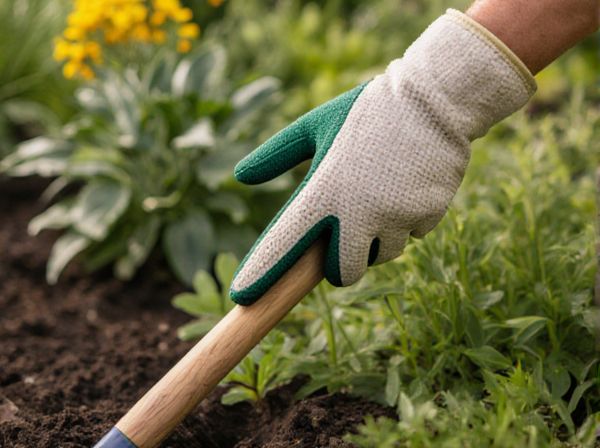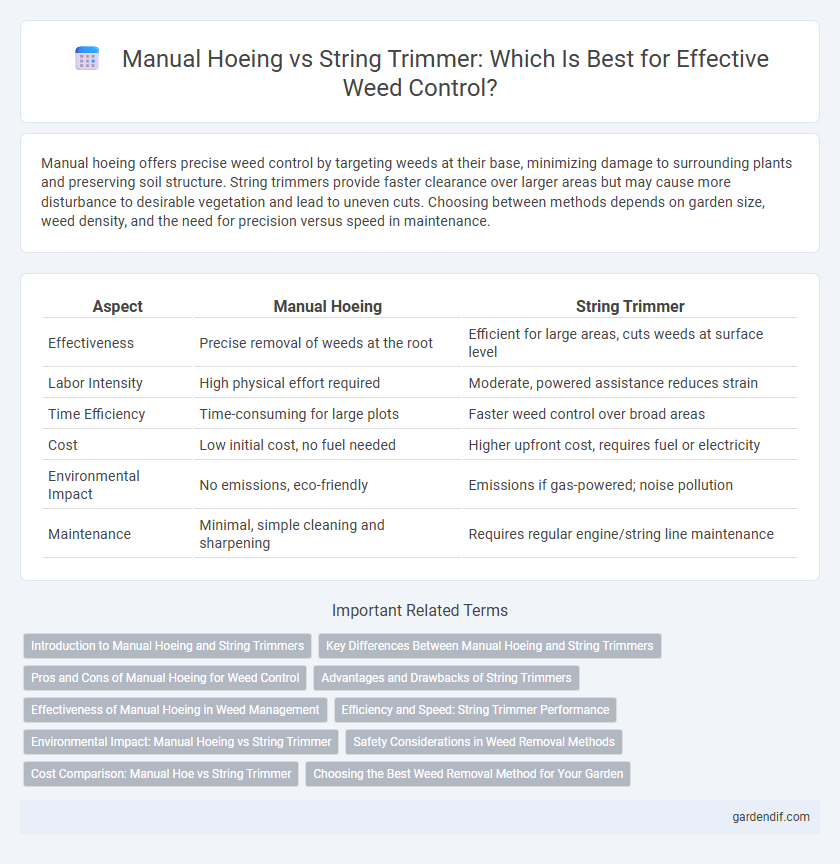
Manual hoeing vs String trimmer Illustration
Manual hoeing offers precise weed control by targeting weeds at their base, minimizing damage to surrounding plants and preserving soil structure. String trimmers provide faster clearance over larger areas but may cause more disturbance to desirable vegetation and lead to uneven cuts. Choosing between methods depends on garden size, weed density, and the need for precision versus speed in maintenance.
Table of Comparison
| Aspect | Manual Hoeing | String Trimmer |
|---|---|---|
| Effectiveness | Precise removal of weeds at the root | Efficient for large areas, cuts weeds at surface level |
| Labor Intensity | High physical effort required | Moderate, powered assistance reduces strain |
| Time Efficiency | Time-consuming for large plots | Faster weed control over broad areas |
| Cost | Low initial cost, no fuel needed | Higher upfront cost, requires fuel or electricity |
| Environmental Impact | No emissions, eco-friendly | Emissions if gas-powered; noise pollution |
| Maintenance | Minimal, simple cleaning and sharpening | Requires regular engine/string line maintenance |
Introduction to Manual Hoeing and String Trimmers
Manual hoeing involves using a handheld hoe to uproot weeds, providing precise control and minimal soil disturbance. String trimmers utilize a rapidly spinning nylon line to cut weeds and grass, offering efficiency for larger areas and tough vegetation. Both methods address weed control but differ in labor intensity, precision, and suitable weed types.
Key Differences Between Manual Hoeing and String Trimmers
Manual hoeing involves physically removing weeds by cutting or uprooting them with a hoe, providing precise control and minimal soil disturbance, ideal for small gardens or tight spaces. String trimmers use a rapidly spinning nylon line to cut weeds, offering faster coverage for larger areas but potentially causing more collateral damage to nearby plants. While manual hoeing promotes soil aeration and targets individual weeds, string trimmers prioritize efficiency and speed in weed management over precision.
Pros and Cons of Manual Hoeing for Weed Control
Manual hoeing for weed control offers precise targeting of unwanted plants, minimizing damage to surrounding crops and reducing chemical use, which is beneficial for organic farming practices. However, it is labor-intensive and time-consuming, making it less efficient for large-scale operations compared to mechanical options like string trimmers. Hoeing also has limited effectiveness against deep-rooted or perennial weeds, requiring frequent intervention to maintain weed management.
Advantages and Drawbacks of String Trimmers
String trimmers offer efficient weed control, especially in hard-to-reach areas and around obstacles, providing quick cleanup with minimal physical strain compared to manual hoeing. However, they require fuel or electricity, generate noise and emissions, and may cause soil disturbance or damage to delicate plants. Despite higher initial costs, string trimmers decrease labor time but demand regular maintenance for optimal performance.
Effectiveness of Manual Hoeing in Weed Management
Manual hoeing offers precise control in weed management by targeting weeds at the root level, reducing regrowth and soil disturbance. This method enhances soil aeration and minimizes damage to adjacent crops, promoting healthier plant development. Compared to string trimmers, manual hoeing provides longer-lasting effectiveness in controlling entrenched weeds in garden beds and small-scale farming.
Efficiency and Speed: String Trimmer Performance
String trimmers offer superior speed and efficiency in weed control compared to manual hoeing, covering larger areas with less physical effort. Their motorized cutting mechanism rapidly trims various weed types, reducing labor time significantly. This performance advantage makes string trimmers ideal for extensive or dense vegetation management tasks.
Environmental Impact: Manual Hoeing vs String Trimmer
Manual hoeing offers a significantly lower environmental impact compared to string trimmers by eliminating fuel consumption and reducing noise pollution, thus preserving local biodiversity and soil health. String trimmers, which often rely on gas or electricity, contribute to carbon emissions, air pollution, and potential soil degradation through mechanical disturbance. Choosing manual hoeing promotes sustainable weed control by maintaining ecological balance and minimizing greenhouse gas emissions.
Safety Considerations in Weed Removal Methods
Manual hoeing offers greater control and reduces the risk of injury from flying debris compared to string trimmers, making it a safer option for precise weed removal near delicate plants. String trimmers pose risks such as cuts, eye injuries, and noise-induced hearing loss without proper protective gear like safety goggles, gloves, and ear protection. Evaluating the specific environment and personal safety equipment availability is crucial when selecting between manual hoeing and string trimming for effective and safe weed control.
Cost Comparison: Manual Hoe vs String Trimmer
Manual hoeing requires minimal initial investment, with basic hoes costing between $10 and $30, making it the most budget-friendly option for weed control. String trimmers involve higher upfront costs, ranging from $50 to over $200 depending on power source and brand, plus ongoing expenses for fuel, batteries, or replacement strings. Maintenance and operational costs also make manual hoeing more economical over time compared to the fuel or electricity dependency of string trimmers.
Choosing the Best Weed Removal Method for Your Garden
Manual hoeing offers precise weed control by targeting roots and minimizing soil disturbance, making it ideal for smaller, delicate garden beds. String trimmers provide fast, broad-area weed removal but can damage desirable plants and compact soil if used improperly. Selecting the best weed removal method depends on garden size, plant sensitivity, and the level of maintenance desired to keep your landscape healthy and weed-free.
Manual hoeing vs String trimmer Infographic

 gardendif.com
gardendif.com